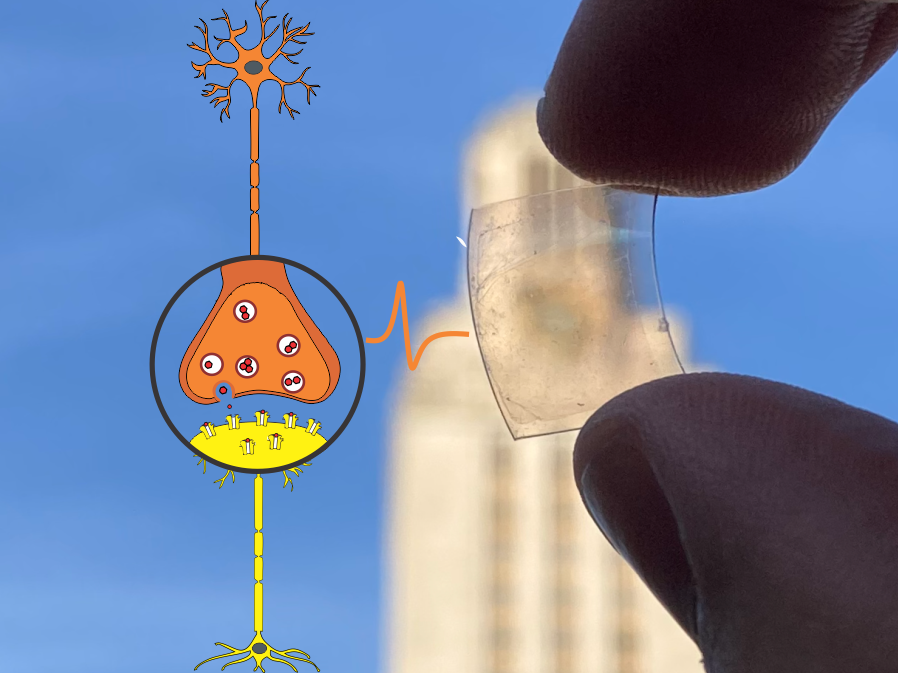Graphene synapses advance brain-like computers
Computers that think more like human brains are inching closer to mainstream adoption. But many unanswered questions remain.

[Aug 12, 2022: Nat Levy, University of Texas at Austin]
A transistor that operates like synapses in the brain. (CREDIT: The University of Texas at Austin)
Computers that think more like human brains are inching closer to mainstream adoption. But many unanswered questions remain. Among the most pressing, what types of materials can serve as the best building blocks to unlock the potential of this new style of computing.
For most traditional computing devices, silicon remains the gold standard. However, there is a movement to use more flexible, efficient and environmentally friendly materials for these brain-like devices.
In a new paper, researchers from The University of Texas at Austin developed synaptic transistors for brain-like computers using the thin, flexible material graphene. These transistors are similar to synapses in the brain, that connect neurons to each other.
"Computers that think like brains can do so much more than today's devices," said Jean Anne Incorvia, an assistant professor in the Cockrell School of Engineering's Department of Electrical and Computer Engineer and the lead author on the paper published in Nature Communications. "And by mimicking synapses, we can teach these devices to learn on the fly, without requiring huge training methods that take up so much power."
Related Stories
Additionally, they discovered that their design increased the amount of power delivered. “We also found that the on-off, switch-like behavior of the diodes actually amplifies the power delivered, rather than reducing it, as previously thought,” said Thibado. “The rate of change in resistance provided by the diodes adds an extra factor to the power.”
The Research: A combination of graphene and nafion, a polymer membrane material, make up the backbone of the synaptic transistor. Together, these materials demonstrate key synaptic-like behaviors — most importantly, the ability for the pathways to strengthen over time as they are used more often, a type of neural muscle memory. In computing, this means that devices will be able to get better at tasks like recognizing and interpreting images over time and do it faster.
Another important finding is that these transistors are biocompatible, which means they can interact with living cells and tissue. That is key for potential applications in medical devices that come into contact with the human body. Most materials used for these early brain-like devices are toxic, so they would not be able to contact living cells in any way.
Energy dissipation normalized by device area and 1% change in conductance as a function of device area. b Benchmarking figure, comparing the BLAST devices (red stars) to other organic polymer-based devices (orange circles) and 2D material based charge trap (purple squares), electrochemical (blue triangles), RRAM (green rhombus) and FET (gray hexagons) devices. (CREDIT: Nature Communications)
Why It Matters: With new high-tech concepts like self-driving cars, drones and robots, we are reaching the limits of what silicon chips can efficiently do in terms of data processing and storage. For these next-generation technologies, a new computing paradigm is needed. Neuromorphic devices mimic processing capabilities of the brain, a powerful computer for immersive tasks.
“Biocompatibility, flexibility, and softness of our artificial synapses is essential,” said Dmitry Kireev, a post-doctoral researcher who co-led the project. “In the future, we envision their direct integration with the human brain, paving the way for futuristic brain prosthesis.”
Will It Really Happen: Neuromorphic platforms are starting to become more common. Leading chipmakers such as Intel and Samsung have either produced neuromorphic chips already or are in the process of developing them. However, current chip materials place limitations on what neuromorphic devices can do, so academic researchers are working hard to find the perfect materials for soft brain-like computers.
"It's still a big open space when it comes to materials; it hasn't been narrowed down to the next big solution to try," Incorvia said. "And it might not be narrowed down to just one solution, with different materials making more sense for different applications."
The Team: The research was led by Incorvia and Deji Akinwande, professor in the Department of Electrical and Computer Engineering. The two have collaborated many times together in the past, and Akinwande is a leading expert in graphene, using it in multiple research breakthroughs, most recently as part of a wearable electronic tattoo for blood pressure monitoring.
The idea for the project was conceived by Samuel Liu, a Ph.D. student and first author on the paper, in a class taught by Akinwande. Kireev then suggested the specific project. Harrison Jin, an undergraduate electrical and computer engineering student, measured the devices and analyzed data.
The team collaborated with T. Patrick Xiao and Christopher Bennett of Sandia National Laboratories, who ran neural network simulations and analyzed the resulting data.
For more environmental news stories check out our Green Impact section at The Brighter Side of News.
Note: Materials provided above by University of Texas at Austin. Content may be edited for style and length.
Like these kind of feel good stories? Get the Brighter Side of News' newsletter.
Joseph Shavit
Head Science News Writer | Communicating Innovation & Discovery
Based in Los Angeles, Joseph Shavit is an accomplished science journalist, head science news writer and co-founder at The Brighter Side of News, where he translates cutting-edge discoveries into compelling stories for a broad audience. With a strong background spanning science, business, product management, media leadership, and entrepreneurship, Joseph brings a unique perspective to science communication. His expertise allows him to uncover the intersection of technological advancements and market potential, shedding light on how groundbreaking research evolves into transformative products and industries.



